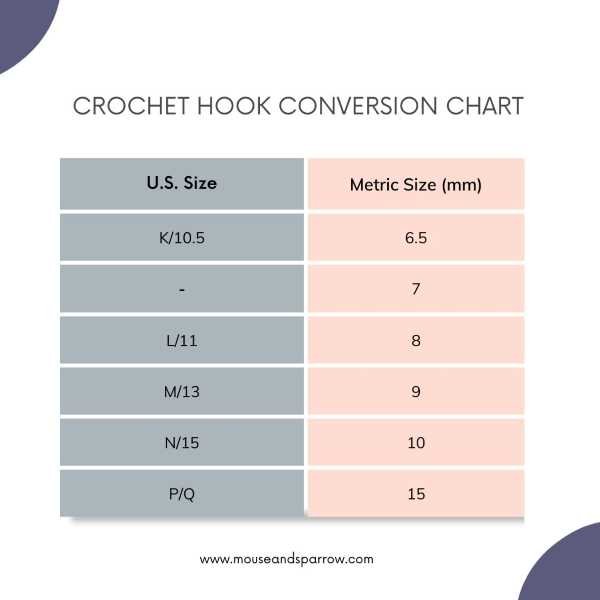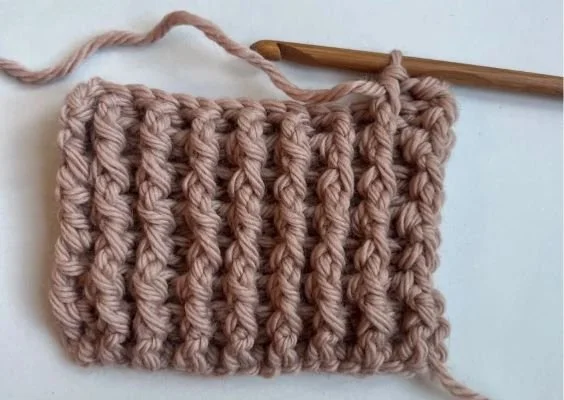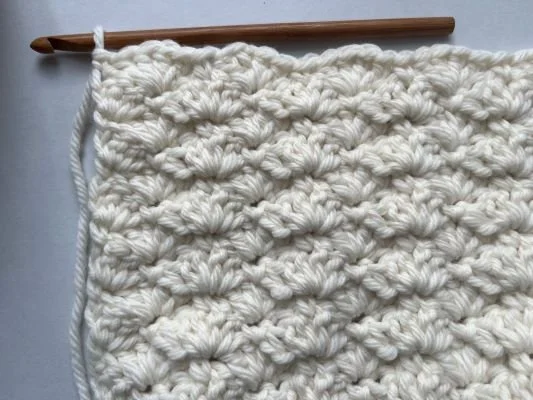What Crochet Hook Size to Use: Complete Hook Guide
This post may contain affiliate links.
If you’re stepping into the world of crochet, you’ve probably found yourself wondering what crochet hook size to use—and maybe feeling a little overwhelmed by the options. With so many sizes and materials available, choosing the right crochet hook can feel like a puzzle.
But don’t worry—this small but mighty tool is easier to understand than it first appears. The size of your hook plays a big role in how your project turns out, from the stretch of a beanie to the drape of a shawl.
And the material of the crochet hook and yarn you choose affects everything from comfort in your hand to the smoothness of your stitches. In this guide, we’ll take a closer look at crochet hook sizes and types, so you can feel confident as you create.
What crochet hook size to use?
Every crochet project begins with two essentials: yarn and a crochet hook.
But not just any hook will do—the crochet hook size you choose has a huge impact on your finished piece. Whether you're working on a scarf or a delicate lace shawl, using the right size hook ensures proper tension, stitch definition, and overall look and feel.
So, what crochet hook size should you use?
The answer depends on several factors: the weight of your yarn, your personal tension, and the type of project you're working on.
Yarn manufacturers typically recommend a specific hook size for each yarn weight.
For example:
Worsted weight yarn usually pairs well with a 5.5 mm (I-9) hook,
Lighter yarns like sport or fingering weight often call for smaller sizes like 3.5 mm (E-4) or even smaller.
These pairings help maintain proper stitch gauge and drape.
The Role of Hook Size in Your Project
The hook size affects:
Gauge and fit – A smaller hook creates tighter stitches, which is ideal for structured items like amigurumi. A larger hook gives looser stitches and more drape—perfect for shawls or flowy garments.
Yarn behavior – Some yarns, especially natural fibers like cotton or wool, behave differently depending on hook size. A too-small hook can make the yarn split or feel stiff, while a too-large hook might make the fabric sag.
Ease on your hands – Larger hooks tend to be easier on the hands and wrists, especially for beginners or those with arthritis.
Overview of Crochet Hook Sizes and Types
Crochet hooks come in a range of sizes, usually measured in millimeters (mm), and often also labeled with letters or numbers depending on the region. The numbering system, which varies slightly between the United States and the metric system, is a code for the thickness of the hook shaft.
The most common systems include:
US letter sizing (e.g., G-6, H-8)
UK/Canada number sizing (e.g., 6, 7, 8)
Metric sizing (e.g., 4 mm, 5.5 mm)
The following chart provides a handy reference for crocheters to convert between U.S. and metric crochet hook sizes.
Crochet Hook Size Chart
Each Crochet Hook Size Has Its Purpose
Just like choosing the right yarn, selecting the right crochet hook size is essential for creating the look, feel, and function you want in a project. Different crochet hook and yarn combinations produce different results—some soft and drapey, others structured and dense. Matching your hook size to the yarn weight helps you achieve the ideal stitch tension, drape, and texture.
Here’s a breakdown of common hook sizes and what they’re typically used for:
B/1 (2.25 mm): A fine hook size perfect for delicate work such as lace, doilies, or projects using fingering or lace-weight yarn. It’s often used for intricate detailing where precision is key.
G/6 (4.0 mm): A versatile middle-of-the-road size that works well with light worsted or DK yarns. Great for hats, scarves, and amigurumi where you want stitch definition and moderate structure.
H/8 (5.0 mm): A go-to size for worsted weight yarn—the most common yarn weight used by crocheters. This size is perfect for blankets, garments, and accessories with a balance of drape and density.
K/10.5 (6.5 mm): Often paired with bulky yarns, this larger hook creates cozy, chunky textures—great for scarves, winter hats, or snuggly throws.
L/11 (8.0 mm) and up: These jumbo-sized hooks are ideal for super bulky or jumbo yarns. They’re used to create quick, oversized projects like chunky blankets, statement cowls, and beginner-friendly pieces with big impact.
By understanding how crochet hook size interacts with yarn weight, you can better control the outcome of your work—whether you want tight, dense stitches for structure, or loose, airy stitches for movement and softness.
Check out this post: How To Pick The Perfect Yarn For Your Next Crochet Project
How to Determine What Crochet Hook Size To Use For Your Projects?
Choosing the right crochet hook size ensures your crochet project turns out just the way you want it.
Most patterns suggest a specific hook size to use with a particular yarn weight, but there is more to it than simply following instructions—it’s about how you interpret and adapt those suggestions to your own tension and the feel you want from your finished piece.
For beginners, start with the yarn label. Most yarns include a recommended hook size based on the yarn’s thickness.
For example:
worsted weight yarns typically suggest a 5.0 mm (H-8) hook,
while lighter yarns might pair with something in the 3.5–4.0 mm range
But here’s the key: the crochet hook and yarn combination you choose affects your fabric’s texture, flexibility, and appearance.
Want a softer, more fluid drape? Try going up a hook size.
Need tighter, denser stitches for something like amigurumi? Try going down a size.
Swatching—crocheting a small sample square—is the best way to test if you’re using the right hook size for your project. It helps you see how your stitches behave and whether your tension matches what the pattern calls for. If the gauge is off, simply adjust your hook size accordingly.
Ultimately, understanding how crochet hook size impacts your work gives you more control and creative freedom as you grow in your craft.
Crochet Hook Types: Finding the Right Tool for Your Craft
Crochet hooks may seem simple, but their material, shape, and design can significantly influence your crocheting experience. The type of crochet hook you use affects not only how it feels in your hand but also how it interacts with the yarn—impacting everything from stitch definition to hand fatigue.
Materials Matter: Types of Crochet Hooks
Crochet hooks are made from a variety of materials, each with its own benefits and quirks:
Aluminum: Lightweight, durable, and smooth, aluminum hooks offer excellent stitch glide. They're a favorite for many beginners and experienced crafters alike.
Steel: Typically used for very small sizes, steel hooks are perfect for delicate lacework and fine threads.
Plastic: Affordable and lightweight, plastic hooks are a good entry point for new crocheters. They’re especially useful for larger hook sizes.
Wood (and Bamboo): Warm to the touch and often beautifully crafted, wooden hooks offer a bit more grip on the yarn, which can be helpful when working with slippery fibers.
Each material affects the “slip” or glide of the yarn and contributes to the overall feel of the crochet process. Some crocheters love the silky smoothness of aluminum, while others prefer the gentle grip of bamboo or the cozy feel of a wooden hook.
The Pros and Cons of Each Material
Aluminium and steel hooks are excellent for their longevity and hookiness (a technical term for staying true to shape), while wood and plastic hooks lend a comforting feel in hand and tenderness to the yarn.
Speciality Hooks for Specific Techniques
Tunisian, also known as ‘Afghan,’ hooks are a hybrid of crochet and knitting, designed for a particular type of project, while lacework hooks possess ultra-sharp tips and fine shafts to navigate intricate patterns.
Some crochet hooks are designed for specific techniques:
Tunisian (Afghan) Hooks: Longer than standard hooks or with a cable attachment, these are used for Tunisian crochet—a hybrid technique blending elements of crochet and knitting.
Lace Hooks: These fine-tipped steel hooks are perfect for intricate lace patterns and thread crochet, often used in doily or vintage-style projects.
Ergonomic Hooks: Designed with comfort grips to reduce hand strain during longer sessions, they’re ideal for anyone with wrist issues or who crochets frequently.
Choosing the Right Crochet Hook: Tying it all Together
So, how do you choose the best crochet hook and yarn combo? It comes down to balance—between comfort, control, and the effect you want to achieve in your finished piece.
Key Factors to Consider:
Yarn Weight: Heavier yarns generally require larger hooks; finer yarns pair with smaller sizes.
Hook Size: Affects the tension, structure, and drape of your project.
Your Crochet Style: Do you naturally crochet tightly or loosely? This will influence whether you should size up or down from the recommended hook.
Matching Hook Size to Yarn Weight
While most yarn labels suggest a crochet hook size that works well with that yarn, don’t be afraid to experiment. Going up a hook size can create looser, airier stitches (perfect for summer shawls), while going down a size tightens everything up—great for stuffed animals or dense fabrics.
Adjusting Hook Size for Tension and Gauge
If your stitches are too tight and your project feels stiff, try moving up a size. If it’s too loose and floppy, go down a size. This is especially important when following a pattern that requires a specific gauge. Swatching helps you get it just right.
What Crochet Hook Sizes Should a Beginner Buy?
If you’re just getting started with crochet, choosing the right hook size can make all the difference. A great place to begin is with medium-sized hooks—specifically sizes between H/8 (5.0 mm) and J/10 (6.0 mm). These pair well with worsted weight yarn, which is beginner-friendly and incredibly versatile.
👉 Tip: You don’t need to invest in a full set right away. Start with a couple of key sizes based on the patterns or yarns you plan to use most. As your skills grow, you can build your collection gradually.
Make It Easier on Your Hands
Many beginners love starting with ergonomic crochet hooks—they’re designed to reduce hand fatigue and provide a more comfortable grip, especially during longer stitching sessions.
🧶 Recommended Ergonomic Hook Set
👉 Try this ergonomic crochet hook set on Amazon – It includes popular sizes, soft grips, and a case for easy storage.
🧵 Stay Organized from the Start
Keeping your hooks tidy helps you stay inspired and stress-free. A hook organizer is a simple but essential tool.
📦 Recommended Crochet Hook Organizer
👉 This stylish crochet hook organizer keeps everything in place – Compact, durable, and great for crafting on the go.
Prefer to make a crochet hook case? Check out this beginner friendly mini crochet kit
More on the topic: Explanations of Crochet Terms for Beginners and Pros
How To Hold Your Crochet Hook
Find What Works for You
The way you hold your crochet hook can make a big difference in your comfort, speed, and even stitch consistency. There’s no one-size-fits-all method—what matters most is finding a grip that feels natural in your hand.
Two of the most common techniques are:
The Pencil Grip – Held like a pencil, this grip gives you precision and is often favored by those who prefer a lighter, more delicate touch.
The Knife Grip – Held like a dinner knife, this grip tends to offer more control and power, especially when working with thicker yarns or tighter stitches.
The Knife Grip
The Pencil Grip
Tips and Techniques for Successful Crocheting
Now that you’re familiar with different crochet hook types and how to choose the right hook and yarn combination, let’s talk about actually putting that hook to work. A few simple techniques can transform your stitching experience from frustrating to fluid.
Staying Taut Without the Tension
Consistent tension is the secret to beautifully even stitches. If your yarn is too loose, your work may look floppy and uneven. Too tight, and your hook won’t glide easily—making crochet feel stiff and tiring.
The goal is balance: let the yarn flow smoothly while maintaining gentle control. Hold your yarn in a way that feels relaxed but steady. This will come more naturally with time, so be patient with yourself—crochet is as much about the journey as the result.
Troubleshooting Common Crochet Issues
Even the most experienced crocheters run into a few hiccups. Here’s how to handle the most common ones:
Yarn Splitting: Try switching to a smoother yarn or using a hook with a rounded head. Splitting often happens with certain fiber types or overly sharp hooks.
Hook Slipping Out of Stitches: This could be due to loose tension or the wrong hook size. Adjust your grip, slow your pace, and don’t be afraid to try a different hook.
Inconsistent Stitch Size: This usually comes down to tension. Practice swatching with different hook sizes until you find your rhythm.
More on the topic: 6 Beginner-Friendly Crochet Projects You Can Finish In A Day
Explore Different Crochet Hooks
As you explore different crochet hooks, remember: progress comes with curiosity and experimentation. Whether you’re trying out a new stitch or challenging yourself to master a new technique, enjoy the process of discovery. Crochet is about more than just creating—it’s an opportunity to experiment, learn, and find your own rhythm.
Each finished piece is a testament to your creativity and growth. With every project, there's more to try, more to learn, and more to enjoy
What’s Your Favourite Crochet Hook?
Do you swear by ergonomic grips, vintage steel hooks, or that one magical size H/8 that never lets you down?
💬 Leave a comment below and tell us which crochet hook you reach for the most—and why you love it!
What’s Next?
Pin this post: Save this tutorial to your Pinterest boards so that you can come back to it later.
Leave a comment: We love to hear your feedback. Tell me in the comments below!
square you master. The fan stitch you've just learned works beautifully as a standalone design element or as part of a larger project.
▶ Eco-friendly crochet kits for beginners
▶ Easy crochet patterns for beginners













Getting the right crochet hat size can feel like guesswork—but it doesn’t have to. In this post, I share 5 simple tips for making hats that actually fit: from measuring correctly to understanding negative ease, choosing the right yarn, and nailing both crown and length. Whether you’re making your first beanie or perfecting your winter projects, these tricks will save you time, yarn, and frustration. Plus, I’ll show you how my printable hat sizing chart and step-by-step pattern can take the mystery out of hat-making so you can get back to the joy of stitching.